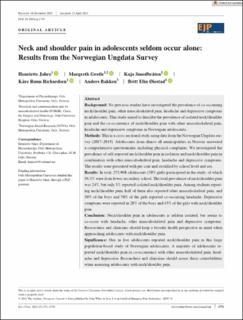| dc.description.abstract | No previous studies have investigated the prevalence of co-occurring neck/shoulder pain, other musculoskeletal pain, headache and depressive symptoms in adolescents. This study aimed to describe the prevalence of isolated neck/shoulder pain and the co-occurrence of neck/shoulder pain with other musculoskeletal pain, headache and depressive symptoms in Norwegian adolescents. Methods: This is a cross-sectional study using data from the Norwegian Ungdata survey (2017–2019). Adolescents from almost all municipalities in Norway answered a comprehensive questionnaire, including physical complaints. We investigated the prevalence of self-reported neck/shoulder pain in isolation and neck/shoulder pain in combination with other musculoskeletal pain, headache and depressive symptoms. The results were presented with per cent and stratified by school level and sex. Results: In total, 253,968 adolescents (50% girls) participated in the study, of which 56.5% were from lower secondary school. The total prevalence of neck/shoulder pain was 24%, but only 5% reported isolated neck/shoulder pain. Among students reporting neck/shoulder pain, half of them also reported other musculoskeletal pain, and 50% of the boys and 70% of the girls reported co-occurring headache. Depressive symptoms were reported in 28% of the boys and 45% of the girls with neck/shoulder pain. Conclusion: Neck/shoulder pain in adolescents is seldom isolated, but seems to co-occur with headache, other musculoskeletal pain and depressive symptoms. Researchers and clinicians should keep a broader health perspective in mind when approaching adolescents with neck/shoulder pain. Significance: One in five adolescents reported neck/shoulder pain in this large population-based study of Norwegian adolescents. A majority of adolescents reported neck/shoulder pain in co-occurrence with other musculoskeletal pain, headache and depression. Researchers and clinicians should assess these comorbidities when assessing adolescents with neck/shoulder pain. | en_US |

